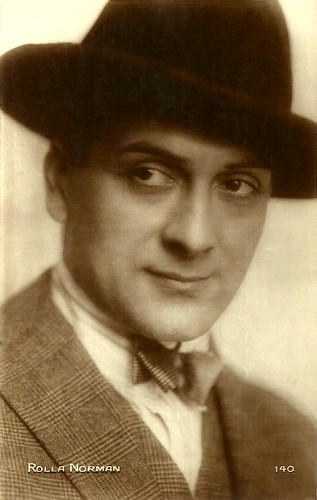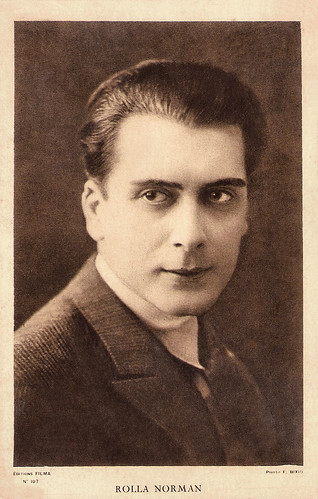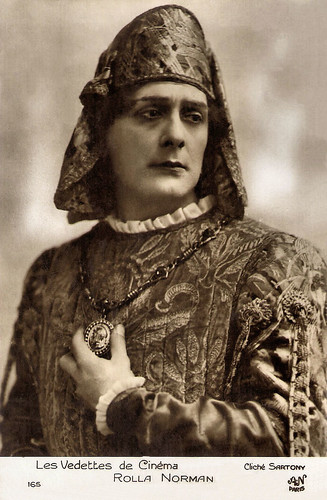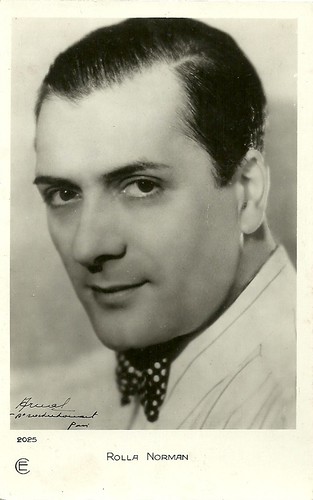Rolla Norman (1889-1971) was a French actor in silent and sound cinema. ‘The Man with Many Faces’ was also a war hero.

French postcard by Editions Cinémagazine, no. 140.
Rolla Norman was born as Edouard Charles Normand in Paris in 1889. He had Alsatian parents, who originally were named Nordmann. They Frenchified it to Normand at the Franco-Prussian war of 1870, when they moved to Paris to sell dairy products.
At a young age, Edouard entered the Conservatoire and won First Prize in Drama and Comedy. He adopted the stage name of Rolla Norman – Rolla referred to the title of a poem by Alfred De Musset which he recited at his graduation at the Conservatoire. Refusing an engagement at the Comédie Française, he started acting instead both on stage and in the cinema, from 1908 on.
Supposedly his first part was in the first Film d’Art production, the short silent film L’assassinat du Duc de Guise/The Assassination of the Duke de Guise (André Calmettes, Charles Le Bargy, 1908). He was 19 at the time.
This appearance was followed by more parts in other Film d’Art productions, all directed by André Calmettes: Louis XI, Le roi de Rome/The King of Rome (1909) with Henri Desfontaines, Héliogabale/Heliogabalus (1909), Rigoletto (1909) with Paul Mounet, and Les enfants d’Edouard (1910) with Émile Dehelly.
From 1909 on, Norman also played for such directors as Albert Capellani, Henri Pouctal and Gérard Bourgeois. In 1912 Norman played in his first feature-length film, an adaptation of Alexandre Dumas Père's Les trois mousquetaires/The Three Musketeers (André Calmettes, Henri Pouctal, 1912). In 1914 he played in the serial Le chevalier de Maison-Rouge/The Knight of the Red House (Albert Capellani, 1914) starring Paul Escoffier and also based on a novel by Alexandre Dumas père. This serial had six sections and 60 episodes.
In 1915 Norman joined the armed forces during WW I and worked in the artillery, thereby almost killing his brother-in-laws who were held in POW camps. After the war, in 1919 he met his future wife and they married. Norman pursued his career in silent cinema, starting in 1919 with Sa gosse/Her Kid (Henri Desfontaines, 1919), starring Elmire Vautier.

French postcard by Editions Filma, no. 107. Photo: F. Bixio.
During the early 1920s Rolla Norman appeared in such films as Une fleur dans la ronce/A Flower in the Brambles (Camille de Morlhon, 1920), Le crime des hommes/The Crime of Men (Gaston Roudès, 1923), Le chant de l’amour triomphant/The Song of the triumphant love (Viktor Tourjansky, 1923) with Jean Angelo, Coeurs farouches/Wild hearts (Julien Duvivier, 1924), Credo ou la tragédie de Lourdes/Credo or the Tragedy of Lourdes (Julien Duvivier, 1924), and L’avocat/The lawyer (Gaston Ravel, 1925) with Sylvio de Pedrelli.
In 1924 he had a capital engagement as the male lead in the French super-production Salammbô (Pierre Marodon, 1925), based on the historical novel by Gustave Flaubert. The première took place at the Opéra Garnier in Paris in 1925. A special score was written by Florent Schmitt for the film. In 1991, the film was beautifully restored and presented at the Avignon music festival. Salammbô was presented again at the first Cinémémoire festival in Paris in 1991, with a huge orchestra and a chorus of 80 singers.
After Salammbô, Norman played in the Alexandre Dumas Père adaptation La dame de Monsoreau/The Lady of Monsoreau (René Le Somptier, 1925), starring Geneviève Félix, the prestigious German-Italian coproduction Der Bastard/Il transatlantico/The Bastard (Gennaro Righelli, 1925) starring Maria Jacobini, Jacques Feyder’s touching Gribiche/Mother of Mine (1926) with Jean Forest and Françoise Rosay.
In the next years followed roles in La veine/The vein (René Barberis, 1928) with Sandra Milowanoff, La grande passion/The big passion (André Hugon, 1928) with Lil Dagover, Das letzte Fort/The Last Fort (Kurt aka Curtis Bernhardt, 1929) with Maria Paudler, and Miss Édith, duchesse/Miss Edith, Duchess (Donatien, 1929) with Lucienne Legrand.

French postcard in the Les Vedettes de Cinéma Series by AN, Paris, no. 165. Photo: Sartony.
Around 1930, after sound film had set in, Rolla Norman went to California, where he played in French versions of productions of the First National studio, including Le masque d’Hollywood (Clarence Badger, John Daumery, 1930) - the alternate language version of Show Girl in Hollywood (1930), Lopez, le bandit (John Daumery, 1930) - the French version of The Bad Man (1930), and Contre-enquête (John Daumery, 1930) - the French version of Those Who Dance (1930), all starring Suzy Vernon.
These were followed by L’aviateur (John Daumery, William A. Seiter, 1931) with Douglas Fairbanks jr. (original: The Aviator (1929)), the MGM production Révolte dans la prison (Pàl Fejos, George W. Hill, 1931) which was the French version of The Big House and which starred Charles Boyer, plus the French version of the Buster Keaton comedy Parlor, Bedroom and Bath: Buster se marie (Claude Autant-Lara, Edward Brophy, 1931).
Disillusioned about Hollywood, Norman returned to France and to the French stage and cinema. Until the outbreak of WW II he played in some twenty French sound films, including Échec et mat/Checkmate (Roger Goupillières, 1931) with Dolly Davis, and the Georges Siménon adaptation Le chien jaune/The Yellow Dog (Jean Tarride, 1932).
Norman’s parts became much smaller in the second half of the 1930s. His last part before he fled France, was in the Franco-Dutch coproduction Notre Dame de la Mouise/Our Lady of the Slums (Robert Péguy, 1941). Shooting for the film had started in 1939, but because of the outbreak of the Second World War, it was interrupted and finished in July 1940. Finally the film was released in France in early 1941.
At the end of 1944 Norman was arrested in his house by the French police, as neighbors had suspected him of collaboration. Instead, it came out that when war had broken out, Norman had gone to the States to enlist in the army and then in the OSS, working as a spy, training resistance fighters and preparing the Normandy landing.
In 1946 he was promoted Commander in the Legion of Honour. After the war Norman played small parts in three more films and then retired in 1950. Rolla Norman died in 1971 at Buc, Yvelines, France. He was 82.

French postcard by Editions Cinémagazine, no. 2025.
Sources: Mammodouy, Wikipedia (French), and IMDb.

French postcard by Editions Cinémagazine, no. 140.
Film d'Art
Rolla Norman was born as Edouard Charles Normand in Paris in 1889. He had Alsatian parents, who originally were named Nordmann. They Frenchified it to Normand at the Franco-Prussian war of 1870, when they moved to Paris to sell dairy products.
At a young age, Edouard entered the Conservatoire and won First Prize in Drama and Comedy. He adopted the stage name of Rolla Norman – Rolla referred to the title of a poem by Alfred De Musset which he recited at his graduation at the Conservatoire. Refusing an engagement at the Comédie Française, he started acting instead both on stage and in the cinema, from 1908 on.
Supposedly his first part was in the first Film d’Art production, the short silent film L’assassinat du Duc de Guise/The Assassination of the Duke de Guise (André Calmettes, Charles Le Bargy, 1908). He was 19 at the time.
This appearance was followed by more parts in other Film d’Art productions, all directed by André Calmettes: Louis XI, Le roi de Rome/The King of Rome (1909) with Henri Desfontaines, Héliogabale/Heliogabalus (1909), Rigoletto (1909) with Paul Mounet, and Les enfants d’Edouard (1910) with Émile Dehelly.
From 1909 on, Norman also played for such directors as Albert Capellani, Henri Pouctal and Gérard Bourgeois. In 1912 Norman played in his first feature-length film, an adaptation of Alexandre Dumas Père's Les trois mousquetaires/The Three Musketeers (André Calmettes, Henri Pouctal, 1912). In 1914 he played in the serial Le chevalier de Maison-Rouge/The Knight of the Red House (Albert Capellani, 1914) starring Paul Escoffier and also based on a novel by Alexandre Dumas père. This serial had six sections and 60 episodes.
In 1915 Norman joined the armed forces during WW I and worked in the artillery, thereby almost killing his brother-in-laws who were held in POW camps. After the war, in 1919 he met his future wife and they married. Norman pursued his career in silent cinema, starting in 1919 with Sa gosse/Her Kid (Henri Desfontaines, 1919), starring Elmire Vautier.

French postcard by Editions Filma, no. 107. Photo: F. Bixio.
Salammbô
During the early 1920s Rolla Norman appeared in such films as Une fleur dans la ronce/A Flower in the Brambles (Camille de Morlhon, 1920), Le crime des hommes/The Crime of Men (Gaston Roudès, 1923), Le chant de l’amour triomphant/The Song of the triumphant love (Viktor Tourjansky, 1923) with Jean Angelo, Coeurs farouches/Wild hearts (Julien Duvivier, 1924), Credo ou la tragédie de Lourdes/Credo or the Tragedy of Lourdes (Julien Duvivier, 1924), and L’avocat/The lawyer (Gaston Ravel, 1925) with Sylvio de Pedrelli.
In 1924 he had a capital engagement as the male lead in the French super-production Salammbô (Pierre Marodon, 1925), based on the historical novel by Gustave Flaubert. The première took place at the Opéra Garnier in Paris in 1925. A special score was written by Florent Schmitt for the film. In 1991, the film was beautifully restored and presented at the Avignon music festival. Salammbô was presented again at the first Cinémémoire festival in Paris in 1991, with a huge orchestra and a chorus of 80 singers.
After Salammbô, Norman played in the Alexandre Dumas Père adaptation La dame de Monsoreau/The Lady of Monsoreau (René Le Somptier, 1925), starring Geneviève Félix, the prestigious German-Italian coproduction Der Bastard/Il transatlantico/The Bastard (Gennaro Righelli, 1925) starring Maria Jacobini, Jacques Feyder’s touching Gribiche/Mother of Mine (1926) with Jean Forest and Françoise Rosay.
In the next years followed roles in La veine/The vein (René Barberis, 1928) with Sandra Milowanoff, La grande passion/The big passion (André Hugon, 1928) with Lil Dagover, Das letzte Fort/The Last Fort (Kurt aka Curtis Bernhardt, 1929) with Maria Paudler, and Miss Édith, duchesse/Miss Edith, Duchess (Donatien, 1929) with Lucienne Legrand.

French postcard in the Les Vedettes de Cinéma Series by AN, Paris, no. 165. Photo: Sartony.
Hollywood
Around 1930, after sound film had set in, Rolla Norman went to California, where he played in French versions of productions of the First National studio, including Le masque d’Hollywood (Clarence Badger, John Daumery, 1930) - the alternate language version of Show Girl in Hollywood (1930), Lopez, le bandit (John Daumery, 1930) - the French version of The Bad Man (1930), and Contre-enquête (John Daumery, 1930) - the French version of Those Who Dance (1930), all starring Suzy Vernon.
These were followed by L’aviateur (John Daumery, William A. Seiter, 1931) with Douglas Fairbanks jr. (original: The Aviator (1929)), the MGM production Révolte dans la prison (Pàl Fejos, George W. Hill, 1931) which was the French version of The Big House and which starred Charles Boyer, plus the French version of the Buster Keaton comedy Parlor, Bedroom and Bath: Buster se marie (Claude Autant-Lara, Edward Brophy, 1931).
Disillusioned about Hollywood, Norman returned to France and to the French stage and cinema. Until the outbreak of WW II he played in some twenty French sound films, including Échec et mat/Checkmate (Roger Goupillières, 1931) with Dolly Davis, and the Georges Siménon adaptation Le chien jaune/The Yellow Dog (Jean Tarride, 1932).
Norman’s parts became much smaller in the second half of the 1930s. His last part before he fled France, was in the Franco-Dutch coproduction Notre Dame de la Mouise/Our Lady of the Slums (Robert Péguy, 1941). Shooting for the film had started in 1939, but because of the outbreak of the Second World War, it was interrupted and finished in July 1940. Finally the film was released in France in early 1941.
At the end of 1944 Norman was arrested in his house by the French police, as neighbors had suspected him of collaboration. Instead, it came out that when war had broken out, Norman had gone to the States to enlist in the army and then in the OSS, working as a spy, training resistance fighters and preparing the Normandy landing.
In 1946 he was promoted Commander in the Legion of Honour. After the war Norman played small parts in three more films and then retired in 1950. Rolla Norman died in 1971 at Buc, Yvelines, France. He was 82.

French postcard by Editions Cinémagazine, no. 2025.
Sources: Mammodouy, Wikipedia (French), and IMDb.
No comments:
Post a Comment